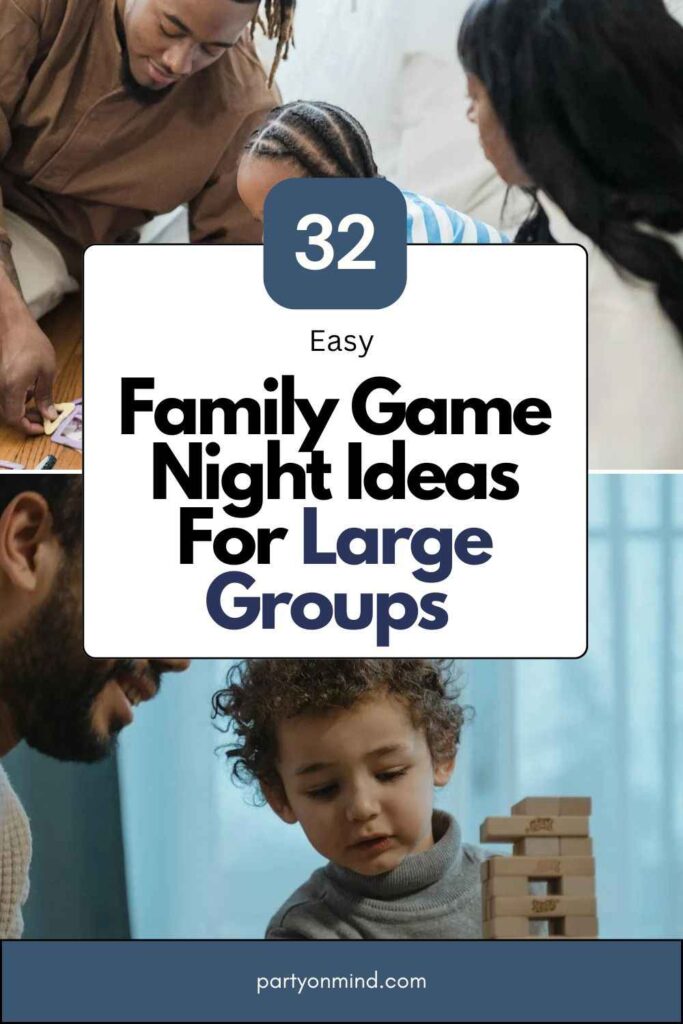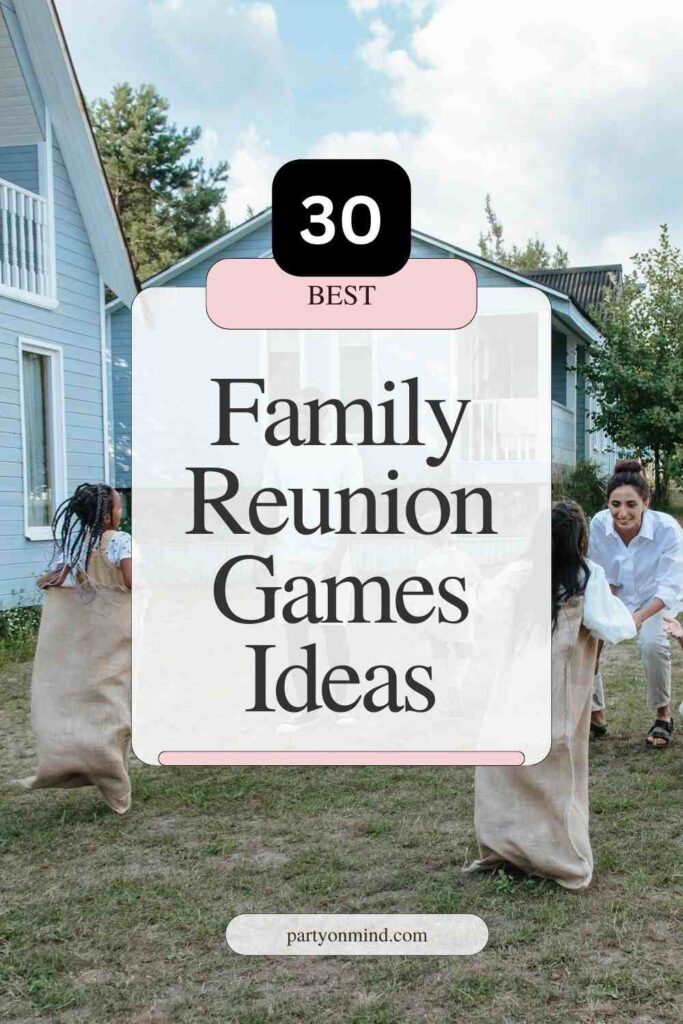Hi, I’m Emma, and I believe there’s nothing better than bringing family and friends together for a night of fun and laughter! Planning Family Game Night Ideas For Large Groups can be a fantastic way to bond, create lasting memories, and enjoy some friendly competition. Whether it’s a mix of kids, teens, and adults or just a gathering of close family members, a well-organized game night ensures everyone feels included and engaged.
Family Game Night Ideas For Large Groups
Family Game Night Ideas For Large Groups bring families together for fun, laughter, and bonding through exciting games. Whether indoors or outdoors, choosing inclusive and engaging activities ensures everyone has a great time!
Charades
In this classic party game, players take turns acting out words or phrases while their team tries to guess them within a time limit. No talking or sounds are allowed, making it a hilarious and engaging game for all ages. The team with the most correct guesses wins. You can theme it based on movies, animals, or family inside jokes.
View this post on Instagram
Tips:
- Use an app or pre-made charade cards for easy word selection.
- Set a timer to keep the game moving.
- Encourage exaggerated gestures for added fun.
- Play in teams to involve everyone.
- Keep categories age-appropriate for younger players.
Pictionary
Teams take turns drawing a word or phrase while their teammates try to guess it before time runs out. Players cannot use letters, numbers, or verbal clues—just their artistic skills. The team with the most correct guesses wins the game. Use a whiteboard or large paper for better visibility.
Tips:
- Use an online Pictionary generator for fresh ideas.
- Set a timer to keep rounds short and exciting.
- Encourage creativity—bad drawings can be the funniest!
- Use different difficulty levels for mixed-age groups.
- Play themed rounds like “Movies,” “Cartoons,” or “Family Memories.”
Minute to Win It Challenges
Each player or team must complete quick, quirky tasks in under 60 seconds. Examples include stacking cups, bouncing ping pong balls into cups, or balancing a cookie on their forehead and moving it to their mouth without hands. Each challenge is simple yet exciting for all ages.
Tips:
- Use household items for budget-friendly fun.
- Keep score or just play for laughs.
- Choose challenges suitable for all skill levels.
- Make sure everyone gets a turn.
- Play music to add energy to the game.
Scavenger Hunt
Players work in teams to find hidden items around the house, yard, or neighborhood. Each team gets a list of objects or clues leading to a final prize. The first team to complete the list or find the final item wins. This game keeps players active and engaged.
Tips:
- Use rhyming clues for added fun.
- Set a time limit to keep the game moving.
- Choose easy and hard items for different age groups.
- Hide objects safely to avoid accidents.
- Offer small prizes for all participants.
Family Feud
Two teams answer survey-based questions to guess the most popular responses. One player from each team tries to guess first, and the team with the highest-ranking answers scores points. The team with the most points at the end wins. Use a whiteboard or printable sheets for easy tracking.
Tips:
- Use an online Family Feud question generator.
- Assign a fun host to read questions.
- Let teams discuss before answering.
- Offer bonus rounds for extra points.
- Adjust questions to suit your family’s interests.
Who Am I?
Players wear a sticky note or card on their forehead with a famous person, character, or family member’s name. They take turns asking yes-or-no questions to figure out their identity. The game continues until everyone guesses their assigned character.
Tips:
- Choose names familiar to all players.
- Set a time limit for each guess.
- Give hints if players get stuck.
- Use themed rounds like “Disney Characters” or “Famous Athletes.”
- Encourage creative questioning strategies.
Jeopardy!
Set up a DIY Jeopardy board with categories and point values. Players or teams take turns selecting categories and answering trivia questions. Correct answers earn points, while wrong answers may result in deductions. The team with the highest score wins.
Tips:
- Use a whiteboard or PowerPoint for a professional setup.
- Include fun family-related categories.
- Mix easy and hard questions for all ages.
- Offer a “Final Jeopardy” round for big comebacks.
- Appoint a game host to keep the game flowing.
Relay Races
Divide players into teams and set up different relay challenges like spoon races, sack races, or obstacle courses. Each player must complete their leg of the race before the next teammate goes. The first team to finish wins. This game is best for outdoor settings.
Tips:
- Use safe, age-appropriate obstacles.
- Make the course short for younger players.
- Play multiple rounds with different challenges.
- Encourage cheering for all teams.
- Offer small prizes for all participants.
The Giant Jenga
Stack large wooden blocks into a tower and take turns removing pieces without toppling the structure. The person who causes the tower to fall loses, and the last successful player wins. This game is great for all ages and adds suspense to the night.
Tips:
- Use an outdoor set for more space.
- Play on a level surface to avoid accidents.
- Add challenges to certain blocks (e.g., “Do a dance before placing your piece”).
- Let younger kids play with smaller versions.
- Set up a camera to capture reactions.
Musical Chairs
Set up chairs in a circle, one less than the number of players. When music plays, players walk around. When the music stops, they must sit. The person left standing is out. Remove one chair each round until one winner remains.
Tips:
- Use upbeat, fun music.
- Have a fair referee to stop the music.
- Add twists like walking backward.
- Make a “second chance” round for younger kids.
- Ensure safe spacing to prevent falls.
Bingo
Each player gets a bingo card with randomized numbers or themed words. A caller announces numbers or words, and players mark their cards. The first to complete a row, column, or diagonal shouts “Bingo!” and wins.
View this post on Instagram
Tips:
- Use themed Bingo cards (movies, holidays, family trivia).
- Offer small prizes for winners.
- Let kids be the callers for added fun.
- Use printable or digital cards.
- Play multiple rounds with different patterns.
Telephone Game
Players sit in a circle, and one person whispers a phrase to the next. Each player passes it on quietly until the last person says it aloud. The final version is usually hilariously different from the original.
Tips:
- Use silly or tricky phrases.
- Encourage players to whisper clearly.
- Play multiple rounds with different themes.
- Let kids create their own phrases.
- Keep it lighthearted—no pressure to get it perfect.
Simon Says
One player acts as “Simon” and gives commands to the group, starting with “Simon says.” Players must follow only the commands that include “Simon says.” If someone acts on a command without “Simon says,” they’re out. The last player remaining wins.
Tips:
- Start with simple commands and gradually increase difficulty.
- Change “Simon” every few rounds for variety.
- Use funny or unexpected commands for laughs.
- Play elimination rounds or time-based versions.
- Keep the pace fast to make it challenging.
Freeze Dance
Players dance to music, but when the music stops, they must freeze in place. Anyone who moves after the music stops is out. The last person remaining wins. This game is great for kids and adults alike.
Tips:
- Use upbeat, high-energy music.
- Have a referee to catch movement.
- Add challenges like “freeze in a funny pose.”
- Allow younger kids extra time before elimination.
- Play multiple rounds to give everyone a fair chance.
Reverse Charades
Instead of one person acting while a team guesses, the whole team acts out the word while one person guesses. This twist makes for hilarious group performances and is perfect for big families.
Tips:
- Choose words that encourage group actions.
- Set a short timer to keep the game moving.
- Make categories like “Animals” or “Famous Scenes.”
- Let kids team up with adults for extra fun.
- Use an app or word generator to get new ideas.
Trivia Night
Divide players into teams and ask trivia questions on various topics. Teams write their answers on paper, and points are awarded for correct answers. The team with the most points at the end wins.
Tips:
- Include questions for all ages.
- Use themed rounds like “Disney,” “Sports,” or “History.”
- Appoint a fun quizmaster to read questions.
- Offer bonus rounds with double points.
- Keep score on a whiteboard for easy tracking.
Balloon Pop Challenge
Each player has a balloon tied to their ankle. The goal is to pop others’ balloons while protecting your own. The last person with an unpopped balloon wins.
Tips:
- Play in an open space to avoid accidents.
- Use soft flooring or grass for safety.
- Pair younger kids with partners for fairness.
- Encourage teamwork and strategy.
- Use different colored balloons for team play.
Wink Murder
One player is secretly chosen as the “murderer.” They discreetly wink at other players to “eliminate” them. If a player gets winked at, they must dramatically fall over. The detective tries to identify the murderer before everyone is out.
Tips:
- Pick a confident detective who enjoys guessing.
- Encourage fun, exaggerated “deaths.”
- Set a time limit to prevent long rounds.
- Play multiple rounds, switching roles.
- Use a flashlight version for a spooky twist.
Hot Potato
Players pass an object (like a soft toy or ball) around while music plays. When the music stops, the person holding it is out. The game continues until one player remains.
Tips:
- Use fast-paced music for excitement.
- Add funny consequences for eliminated players.
- Make a special rule where younger kids get a second chance.
- Play multiple rounds to keep everyone engaged.
- Use a timer instead of music for a variation.
Tips for Hosting a Successful Family Game Night
A well-planned family game night can bring everyone together for fun, laughter, and bonding. Whether you’re hosting a small gathering or a large group, making sure everyone feels included and engaged is key. Here are some essential tips to ensure a memorable and enjoyable experience for all.
Setting Up a Comfortable and Engaging Space
- Arrange seating so everyone has a good view of the game.
- Choose a well-lit area to avoid eye strain.
- Have a mix of chairs, cushions, or floor seating for comfort.
- Minimize distractions by turning off the TV and silencing phones.
- Use a central table or large open space for board games or active play.
Ensuring Everyone Gets a Turn and Feels Included
- Pick games that are suitable for all ages and skill levels.
- Rotate roles so everyone has a chance to lead or participate equally.
- Encourage teamwork and pair younger kids with adults if needed.
- Set clear rules to ensure fairness and avoid arguments.
- Let shy or quieter players start with observation before joining in.
Keeping Score (or Playing Just for Fun!)
- Decide beforehand whether to keep score or just play for enjoyment.
- Use a scoreboard or whiteboard for competitive games.
- Assign a scorekeeper who keeps track of points fairly.
- Offer alternative scoring methods, like team-based points.
- If playing just for fun, focus on enjoying the experience over winning.
Having Prizes or Small Rewards for Extra Excitement
- Offer small prizes like candy, stickers, or mini trophies.
- Consider funny awards like “Best Dance Moves” or “Most Creative Answer.”
- Use a reward system where everyone gets a little something.
- Give bonus points for great teamwork or sportsmanship.
- Keep prizes lighthearted and optional to maintain a fun atmosphere.
Providing Snacks and Drinks to Keep the Energy Up
- Serve easy-to-eat finger foods like popcorn, chips, or fruit slices.
- Keep drinks accessible to avoid constant trips to the kitchen.
- Offer a mix of sweet and savory snacks for variety.
- Avoid messy foods that might interfere with the games.
- Set up a snack station so players can grab a bite between rounds.
With these tips in place, your family game night will be a hit, ensuring laughter, bonding, and lasting memories for everyone involved!
FAQ
What are the best types of games for large groups?
Games that encourage teamwork, interaction, and active participation work best. Some great options include trivia, charades, relay races, board games with team play, and interactive games like “Simon Says” or “Wink Murder.”
How do I make sure everyone stays engaged and included?
Choose games that allow multiple players to participate at once. Rotate turns fairly, mix up teams for variety, and include both competitive and just-for-fun games. Adjust rules if needed to accommodate different ages and skill levels.
What space is best for a large group game night?
It depends on the games you plan to play. If you’re playing active games like relay races or balloon pop challenges, an open living room or backyard works best. For board games or trivia, a large table with enough seating is ideal.
How do I keep the game night organized with a big group?
- Plan ahead by selecting a mix of games suited for all ages.
- Have a game schedule or list to keep the event flowing smoothly.
- Assign someone as a game host to explain the rules and keep track of turns.
- Use a scoreboard or team-based system to keep competition fun but fair.

I’m Emma Rosenthal, an event planner based in New York City with a passion for bringing people together through unforgettable celebrations. I created partyonmind.com to share my best party ideas, wedding inspirations, and fun games for kids, adults, and everyone in between. Whether you’re planning a small gathering or a grand event, I love helping you make every occasion special with creative and engaging activities. Let’s make every party one to remember!
![Fun Party Games Ideas for Kids, Adults [Party On Mind]](https://partyonmind.com/wp-content/uploads/2025/02/on-1-316x90.png)




